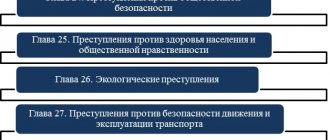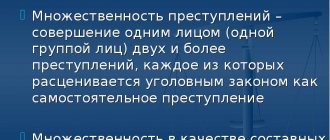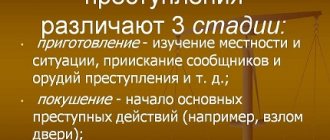The concept of corpus delicti
The corpus delicti is a set of objective and subjective characteristics provided for by criminal law that characterize a socially dangerous act as a crime.
An element of a crime is a generalized legally significant property specified in the law, inherent in all crimes of a given type. The norms of the Special Part of the Criminal Code of the Russian Federation describe the signs that reflect the specifics of a particular crime, and the norms of the General Part of the Criminal Code of the Russian Federation give signs that are characteristic of all crimes without exception (the age at which criminal liability begins and sanity). The signs characterizing a specific crime form a system of signs; the absence of at least one of them means the absence of the crime as a whole.
The composition of any crime is formed by four groups of signs, distinguished by its elements.
An element of a crime as a structural part of the composition, consisting of a group of signs corresponding to various aspects of the crime. In total, there are four elements of the crime:
- object of crime;
- the objective side of the crime;
- the subjective side of the crime;
- subject of the crime.
The signs that characterize the object and the objective side of the crime are called objective signs of the crime ; the characteristics inherent in the subjective side and the subject of the crime are called subjective characteristics of the .
Depending on the meaning of the legal characteristics of the crime, they are divided into mandatory and optional.
The characteristics included in all crimes are considered mandatory These include:
- public relations;
- socially dangerous act (action or inaction);
- guilt in the form of intent or negligence;
- the sanity of the person and his attainment of the age at which, according to the law, criminal liability for this crime begins.
Optional features are those that are not inherent in all elements of a crime, but only in some of them. With their help, the legislator, when constructing criminal law norms, reflects additional features that express the specificity of a particular crime. These include:
- the subject of the crime, the victim of the crime;
- criminal consequences;
- the causal relationship between the act and the consequences;
- circumstances of time and place;
- method, situation, instruments and means of committing a crime;
- motive and purpose of the crime;
- special characteristics of the subject of the crime (special subject).
The meaning of optional elements of a crime in criminal law:
- by the legislator they can be included in the main element of the crime and, in connection with this, become mandatory (constitutive) (for example, a secret method of confiscating someone else’s property is a mandatory sign of theft - Article 158 of the Criminal Code of the Russian Federation);
- they can act as a qualifying feature that increases or, conversely, reduces the danger of a crime and changes the main type of crime to its qualified type (for example, a generally dangerous method of murder, special cruelty - clauses “d”, “f”, part 2 of Art. 105 of the Criminal Code of the Russian Federation; conditions of a psychotraumatic situation - Article 106 of the Criminal Code of the Russian Federation);
- if they are not mandatory (not included in the main part of the crime) and are not indicated as qualifying characteristics, then according to Art. 61 and the Criminal Code of the Russian Federation can act as circumstances mitigating or aggravating punishment (for example, methods such as sadism, torture, mockery of the victim are recognized as aggravating punishment; minority, pregnancy, motive of compassion - mitigating).
QUESTION 15. TYPES OF CRIMES.
The classification of crimes in the theory of criminal law is carried out according to several criteria . Among them are:
1. degree of public danger;
2. legislative construction (construction of the corpus delicti on its objective side);
3. structure of the composition depending on the number of its characteristics of the same type;
4. range of acts covered by the composition.
1. Types of crimes depending on the degree of public danger
According to the degree of public danger, crimes are divided into the following types:
1.
main composition
2.
qualified composition
3.
composition with mitigating circumstances
The main composition is a composition that includes constructive (mandatory) features of a specific crime without indicating aggravating or mitigating circumstances .
A qualified crime is a crime that, along with the constructive features of the main crime,
additionally contains one or more aggravating circumstances (qualifying features). Their presence indicates a higher degree of social danger of the crime compared to a crime with the main elements . This is reflected in the more severe sanctions provided for in the article of the Criminal Code for such a crime. Within the framework of a qualified offense, particularly qualified offenses are distinguished, which contain qualifying features that further increase the degree of public danger of the crime.
For a crime with a particularly qualified composition, an even more severe sanction is provided in comparison with the sanction provided for a crime with a qualified composition. A composition with mitigating circumstances is a composition when, along with the constructive features of the main element of the crime
The law
contains mitigating circumstances indicating a lower degree of public danger of this crime compared to a crime with the main elements .
This is also reflected in the sanction of the relevant article, which is less stringent compared to the sanction provided for the main crime. The main elements of crimes
are provided, as a rule, in the first parts of the articles of the Special Part of the Criminal Code . Qualified and especially qualified personnel are provided for second, third, etc. parts of the articles of the Special Part of the Criminal Code . Compositions with mitigating circumstances are, as a rule, provided for in independent articles of the Criminal Code .
For example, in Part 1 of Art. 139 of the Criminal Code provides for the main elements of murder as the intentional unlawful deprivation of the life of another person. The sanction of this norm provides for punishment in the form of imprisonment for a term of 6 to 15 years. Part 2 of the same article provides for a qualified corpus delicti of murder, indicating the qualifying characteristics placed in 16 points. The sanction of this norm provides for punishment in the form of imprisonment for a term of 8 to 25 years, life imprisonment or the death penalty.
In Art. 140 of the Criminal Code provides for murder with mitigating circumstances, i.e. murder by a mother of a newborn child during childbirth or immediately after it, committed in a psychotraumatic situation caused by childbirth. The sanction of this article provides for punishment in the form of restriction of freedom for a term of up to 5 years or imprisonment for the same period. This sanction is less severe than the sanction provided for in Part 1 of Art. 139 and, naturally, than that provided for in Part 2 of the same article.
The elements of murder with mitigating circumstances are also elements provided for in Art. 141 (murder committed in a state of passion), Art. 142 (murder by exceeding the measures necessary to apprehend the person who committed the crime), Art. 143 (murder when exceeding the limits of necessary defense). All these articles provide for the elements of the basic elements of murder and, in addition, indicate mitigating circumstances that reduce the degree of public danger of the crime.
2. Types of crimes depending on the legislative structure
According to the legislative design (according to the design of the objective side of the crime), the offenses are divided into:
1.
material;
2.
formal .
Material composition is such a crime, the objective side of which presupposes the presence of a socially dangerous act, a socially dangerous consequence that occurred as a result of this act, and a causal relationship between them . In this case, material compositions in the law are described in the following ways:
1) by direct indication of a socially dangerous act and socially dangerous consequences
;
2) by indicating a socially dangerous act, when socially dangerous consequences are expected to occur as a result of its commission
;
3) by indicating the social consequence that occurs as a result of the act committed
.
As an example of using the first method, Art. 227 of the Criminal Code, which provides for liability for forgery of a securities prospectus, resulting in damage to investors on an especially large scale. This legislative construction of the composition suggests that this act, expressed in the inclusion by an official of a securities prospectus of knowingly false information or the certification of a prospectus containing knowingly false information, will be recognized as a crime only if it entails the consequences specified in this article . In this case, the law, when describing the material composition, uses an indication of both the act and the consequences. A similar method is used in Art. 264 - 267, 424, 425, 428 and other articles of the Criminal Code.
The second method is used, for example, in Art. 205 of the Criminal Code, which provides for liability for theft, i.e. secret theft of property. By constructing such a composition, the law indicates only a socially dangerous act, but assumes that as a result of its commission, socially dangerous consequences will occur in the form of causing material damage to the owner of the property . A similar approach to describing the material elements of a crime is contained in Art. 206, 209 - 212 CC, etc.
As an example of the third method, we can cite such crimes as causing grievous bodily harm (Article 147 of the Criminal Code), intentional deprivation of professional ability to work (Article 148 of the Criminal Code), intentional destruction or damage to property (Article 218 of the Criminal Code) and others. In these cases, the law places emphasis on the very consequences that occurred as a result of the committed act .
In other words, the material composition always presupposes the presence of socially dangerous consequences as a mandatory sign of the objective side of the crime .
Formal composition is such a crime, the obligatory sign of the objective side of which is a socially dangerous act . Responsibility for this act occurs regardless of the consequences
.
The absence of an indication in the law of socially dangerous consequences means that they are not a mandatory sign of the objective side of this crime. For example, the formal elements of crimes are those provided for in Art.
188 (slander), art. 189 (insult) Art. 223 (violation of rules on transactions with precious metals and stones), Art. 228 (smuggling), Art. 259 (falsification of measuring instruments), etc. A type of formal crime is a truncated . This is such a crime, the objective side of which includes some forms of preparatory actions or actions that constitute an attempt to commit this crime . Truncated offenses are formulated taking into account the need to make the crime more dangerous . Therefore, the legislator recognizes the presence of all the signs of a completed crime already at the stages of preliminary criminal activity, although in other cases similar actions are considered only as preparation for a crime or an attempt to commit a crime.
Truncated crimes include, for example, banditry in the form of creating a gang (Article 286), conspiracy to seize state power (Part 1 of Article 357), a terrorist act (Article 359), etc. Robbery was recognized as a truncated crime. considered by the 1960 Criminal Code as an assault. However, the attack itself, in our opinion, should not have been considered an attempted crime; it was an act that should have been recognized as a crime, regardless of the achievement of the goal of taking possession of property. Robbery as it is formulated in the new Criminal Code generally excludes the possibility of classifying it as a truncated offense, since the use of violence dangerous to the life or health of the victim or the threat of using such violence for the purpose of direct seizure of property already constitutes an action, and not preparation for it or an attempt on him (v. 207).
Types of crimes depending on their structure
According to the structure, i.e., depending on the number of signs of the same type contained in its composition, the elements of the crime are divided into:
1.
simple;
2.
complex.
Simple compositions are those “that contain one separate attribute of a certain type: one act directed against one object, committed with one form of guilt and entailing one consequence ”[5].
Complex compounds are compounds containing two or more similar features , for example, two or more objects of a crime, two acts that act as mandatory features of the objective side of the crime, forming it only in the aggregate, two or more alternative acts, any of which forms the objective side , two or more socially dangerous consequences, acting as alternative signs of the objective side of a given crime, two forms of guilt (when there is complex guilt, i.e. a combination of intent and negligence when committing a specific crime).
As an example of a simple crime, one can cite murder (Part 1 of Article 139 of the Criminal Code), causing death by negligence (Article 144 of the Criminal Code), theft (Part 1 of Article 205 of the Criminal Code), robbery (Part 1 of Article 206 of the Criminal Code ) and etc.
Complex crimes are usually divided into the following types
:
with two or more objects
;
· with two or more actions;
with two or more consequences;
with two forms of guilt
[6].
A crime with two objects is, for example, rape, which through negligence resulted in the death of the victim (Part 3 of Article 166 of the Criminal Code), since when committing this crime, harm is caused not only to a woman’s sexual freedom, but also to her life.
A crime with two or more actions, only together forming a completed crime, is, for example, the theft of a motor vehicle or a small watercraft (Part 1 of Article 214), since this crime consists of two actions: the unlawful taking of a vehicle or a watercraft ship and travel on it. A complex composition with two or more actions will also be one whose objective side is formed by any of the alternative actions provided for in a specific article of the Criminal Code. For example, a crime under Art. 240 of the Criminal Code “Intentional Bankruptcy”, any of the actions specified in it is recognized: the deliberate creation of insolvency or the deliberate increase in insolvency, committed by an individual entrepreneur or an official of a legal entity in personal interests or in the interests of other persons.
A crime with two or more consequences, the occurrence of which together forms the objective side of the completed crime, is, for example, the intentional destruction or damage of property, causing damage in a significant amount (Part 1 of Article 218). The very destruction or damage to property, which acts as a consequence of this crime, forms its objective side only in conjunction with the onset of consequences in the form of damage in a significant amount. At the same time, a complex composition with two or more consequences will also be a composition whose objective side is formed by two or more alternative consequences. An example of such a composition is the composition provided for in Part 2 of Art. 161 - failure to provide assistance to a patient, which through negligence resulted in the death of the patient or the infliction of serious bodily injury.
The elements of a crime with two forms of guilt are such elements of crime when in relation to the act committed the person had an intentional form of guilt, and in relation to the consequences that occurred, with which the law associates increased liability - careless guilt. For example, rape, which through negligence resulted in the death of the victim, or the infliction of grievous bodily harm, or HIV infection, or other grave consequences (Part 3 of Article 166 of the Criminal Code).
Complex offenses in the literature also include a single offense with alternative features , the concept of which was introduced into scientific use by A.I. Lukashov. Recognition of the presence of this type of complex composition is due to the design features of the articles of the Special Part of the Criminal Code .
Let us refer to the author’s own justifications for this type of complex crime. Differentiation of criminal liability using the design of a single crime with alternative signs is carried out by the legislator, taking into account the different magnitude of the social danger of the act committed in the presence of certain alternative signs that characterize it. In order to take this circumstance into account, the legislator distributes the elements of a crime into several parts, the sanctions of which, starting with the sanction of part two, are more stringent compared to the sanction of part one. When formulating uniform crimes with alternative characteristics, the legislator, in the first part of the article, provides a description of the crime, including basic, initial characteristics, and often completes this description with the name of this crime, given in parentheses. The corpus delicti obtained in this way, called the basic corpus delicti, is combined in the first and subsequent parts of the relevant article with alternative characteristics, the number of which in one part of the article ranges from one to three. At the same time, in the parts of the article following part one, the basic elements of the crime are not reproduced. They only give its name, accompanied by an alternative attribute(s). The basic corpus delicti, together with all the alternative features, forms a single corpus delicti with alternative features[7].
These alternative characteristics are not related to each other. In order for actions (inaction) to form the corpus delicti of a completed crime, it is sufficient that they contain the basic corpus delicti and at least one of several alternative signs of a single corpus delicti. If the act contains several alternative characteristics, it is qualified under that part of the article of the Special Part of the Criminal Code, which provides for more stringent liability. However, when formulating the charge, it includes all the alternative elements of the crime that must be taken into account when determining the degree of responsibility of the perpetrator[8].
It must be borne in mind that the same article of the Special Part of the Criminal Code may contain a single composition with alternative characteristics, as well as qualifying elements of the crime provided for in Part 1 of the article of the Criminal Code[9]. It is necessary to distinguish them from each other when qualifying crimes committed.
Types of crimes depending on the range of acts covered
Based on the range of acts covered, crimes are divided into: general and special .
The general corpus delicti is one that contains features characteristic of a number of similar crimes .
A special corpus delicti is one that contains the main features of the general corpus delicti and, in addition, is characterized by special features that give it independent meaning .
When there is competition between general and special crimes,
the committed act is qualified under an article of the Criminal Code that provides for a special crime . For example, in Part 1 of Art.
139 of the Criminal Code contains elements of murder. The special corpus delicti of this crime is the corpus delicti provided for in Art. 140 (murder of a newborn child by a mother). This article, in addition to the general signs of murder, provides for special signs that act in this case as circumstances mitigating responsibility. This article retains all the signs of the general composition - murder. Special composition in relation to murder provided for in Part 2 of Art. 139 of the Criminal Code is the murder of a police officer, provided for in Art. 362 of the Criminal Code, in which, to the general characteristics of a murder committed against a person in connection with the performance of his official activities or the performance of a public duty (clause 10), signs characterizing the victim (police officer) and the type of his activity (performing duties to protect public order) are added ), in connection with which the crime was committed.
Or, for example, in Art. 427 of the Criminal Code provides for a general crime - official forgery. Special in relation to this composition is the corpus delicti provided for in Art. 227 of the Criminal Code - forgery of a securities prospectus, which retains the basic features of the general composition (entry by an official of knowingly false information and entries into official documents, or forgery of documents, or the preparation and issuance of deliberately false documents), but introduces features related to the nature of the document (prospectus for the issue of securities) and the consequences of this crime (causing damage to investors on an especially large scale).
Thus, the Criminal Code of the Republic of Belarus provides for several types of crimes; understanding their essence will help not only to understand questions about the composition of the crime, but also to correctly apply the norms of the Criminal Code in practice.
The meaning of the crime
The significance of the crime lies in the fact that its presence in a specific socially dangerous act makes it possible to recognize the latter as a crime and qualify it under a certain article of the Criminal Code; in accordance with Art. 8 of the Criminal Code of the Russian Federation serves as a necessary and sufficient basis for bringing a person to criminal liability.
The concepts of crime and corpus delicti are inextricably linked with each other and refer to the same phenomenon of objective reality - a socially dangerous act provided for by criminal law. The first of them mainly characterizes the social essence of a criminal act, and the second - its legal structure and necessary properties. Consequently, the concept of a crime covers a real phenomenon, and the corpus delicti acts as a legal concept about this phenomenon.
The essence and significance of the classification of crimes in criminal law
Definition 1
Classification of crimes is the differentiation of crimes committed within the framework of criminal law into certain groups, based on some criterion.
As a basis for classifying crimes, one can consider their social danger in general or some specific sign of the crimes being committed; in addition, a combination of such signs can be used in classification.
If we consider the practical aspect of classification, then such a classification of crimes within the framework of criminal law acquires particular importance in law enforcement practice, since it directly forms a special regime for the functioning of the General and Special Parts of the Criminal Code of the Russian Federation, various types of criminal legal institutions and norms, within the framework of subjects of such legal relations open up new opportunities for protecting legitimate interests with the greatest efficiency.
Are you an expert in this subject area? We invite you to become the author of the Directory Working Conditions
The importance of classifying crimes within criminal legal relations can be characterized by the following aspects. This classification:
- provides an opportunity to study the content of the institutions included in criminal legislation, as well as clearly establish the purpose of various classification groups;
- allows us to present similar studied phenomena in a scientifically substantiated form, to most effectively identify their relationships and subordination;
- has a beneficial effect on the study of the criminal legal institutions under study in a detailed form, and also groups their diverse and, in some cases, contradictory manifestations in the course of practical implementation;
- acts as one of the most effective tools for systematization as one of the forms of scientific generalization, and also connects the acquired knowledge in this field into a single holistic system;
- establishes relationships within classification groups, highlighting negative aspects in the field of criminal legislation, which significantly increases the efficiency of scientific research on issues of continuous improvement of legislation regulating criminal offenses.
Finished works on a similar topic
Course work Classification of crimes in Russian criminal law: content, criteria and meaning 490 ₽ Abstract Classification of crimes in Russian criminal law: content, criteria and meaning 250 ₽ Test work Classification of crimes in Russian criminal law: content, criteria and meaning 190 ₽
Receive completed work or specialist advice on your educational project Find out the cost









